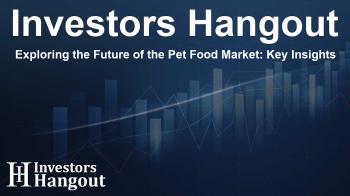Exploring the Future of the Pet Food Market: Key Insights

Growth of the Pet Food Market
The pet food market is witnessing an impressive growth trajectory, projected to expand by USD 41 billion from 2024 to 2028. This growth is underpinned by several factors, particularly the growing demand for organic and nutritious products for pets. According to recent market analyses, the industry is expected to experience a compound annual growth rate (CAGR) of around 6.15% over this timeframe.
Trends Shaping the Market
Demand for Organic Products
With the increased awareness of pet health among owners, organic pet food is gaining significant traction. The trend is primarily driven by pet owners seeking high-quality, nutritious food options. This encompasses a shift towards pet food with savory ingredients, along with preferences for smaller portions to accommodate various pet sizes, especially among smaller dog breeds.
AI Influence on Market Dynamics
Innovative technologies such as artificial intelligence are playing a substantial role in transforming the pet food landscape. AI helps manufacturers to better analyze consumer trends and develop offerings that align with the evolving health needs of pets. This technological advancement is paving the way for efficiency and effectiveness in production processes, ensuring that companies can meet market demands quickly.
Challenges in the Pet Food Industry
Despite the growth, the market faces several challenges. Key issues include ensuring that the nutritional requirements for pets, particularly for dogs and cats, are met through high-quality ingredients. The complexity of dietary needs extends to other pets too, necessitating careful ingredient selection and meal preparation.
Health Concerns Among Pets
Health issues like obesity, diabetes, and skin allergies continue to pose challenges for pet owners and manufacturers alike. The demand for specialized diets tailored to address these health concerns is on the rise, compelling pet food brands to innovate and develop formulas that align with these needs.
Market Segmentation Insights
The pet food market segmentation reveals key insights into consumer preferences. Major categories include dry food, wet food, and treats. Dry food remains a popular choice due to its benefits such as convenience and its supportive role in maintaining dental hygiene through chewing.
Product Variety and Tailored Nutrition
Manufacturers are increasingly offering tailored nutritional products, catering to specific health issues faced by pets, thereby enabling pet owners to select food that addresses their pets' unique needs. This trend is prominently seen in the increasing availability of both animal-based and plant-based protein options.
Brand Innovations in Pet Food
Key players in the industry, including notable names, are actively launching products that reflect current trends. For example, innovative brands have recently introduced a mixture of hard kibble with tender meat, enhancing flavor choices for pets. This innovation is indicative of how the market is evolving to meet consumer expectations for quality and taste.
Millennial Influence on Pet Premiumization
Millennials are significantly influencing the pet food sector through a trend known as pet premiumization. This group prioritizes their pets' diets and is willing to invest in higher-quality products. As a result, the market is seeing increased demand for premium dry and wet food options.
Insights Into Retail Dynamics
The distribution landscape for pet food includes both offline and online channels. Retailers are increasingly offering a vast selection of snacks and treat options, which further cater to the evolving preferences of pet owners. This versatility in purchasing options allows consumers to meet their pets' dietary needs effectively.
Future Outlook for the Pet Food Market
As the pet population continues to grow, the market for pet food is expected to thrive. Increased spending on veterinary care and pet supplies will further fuel this growth. The emphasis on premium products highlights a shift in consumer behavior, where pet owners invest in higher-quality food to ensure the health and well-being of their furry companions.
Frequently Asked Questions
What is driving the growth of the pet food market?
The growth is primarily driven by an increasing demand for organic products and greater awareness of pet health among owners.
How is AI influencing the pet food industry?
AI is improving market analysis and production efficiency, helping manufacturers adapt to changing consumer preferences effectively.
What are some major challenges facing the pet food market?
Challenges include meeting nutritional requirements, addressing health concerns, and adapting to changing consumer trends.
What innovations are being introduced in the pet food sector?
Brands are focusing on launching products that combine various textures and flavors, enhancing the dining experience for pets.
How are millennial consumers impacting pet food choices?
Millennials prioritize premium products and are significantly contributing to the trend of pet premiumization by spending more on high-quality food.
About Investors Hangout
Investors Hangout is a leading online stock forum for financial discussion and learning, offering a wide range of free tools and resources. It draws in traders of all levels, who exchange market knowledge, investigate trading tactics, and keep an eye on industry developments in real time. Featuring financial articles, stock message boards, quotes, charts, company profiles, and live news updates. Through cooperative learning and a wealth of informational resources, it helps users from novices creating their first portfolios to experts honing their techniques. Join Investors Hangout today: https://investorshangout.com/
Disclaimer: The content of this article is solely for general informational purposes only; it does not represent legal, financial, or investment advice. Investors Hangout does not offer financial advice; the author is not a licensed financial advisor. Consult a qualified advisor before making any financial or investment decisions based on this article. The author's interpretation of publicly available data shapes the opinions presented here; as a result, they should not be taken as advice to purchase, sell, or hold any securities mentioned or any other investments. The author does not guarantee the accuracy, completeness, or timeliness of any material, providing it "as is." Information and market conditions may change; past performance is not indicative of future outcomes. If any of the material offered here is inaccurate, please contact us for corrections.
